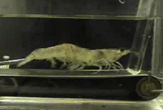Scientists Put Shrimp on a Treadmill
A sluggish, sick human is easy to spot. But it's harder to tell when a shrimp is under the weather. So one scientist put the little crustaceans on a tiny treadmill to examine how diseases impact their performance.
Humans fighting an infection typically sleep more and are not at top physical performance. "The situation is much more critical for a sick marine crustacean, such as a shrimp, where a decrease in performance may mean the difference between life and death," said David Scholnick, a biologist from Pacific University in Oregon.
The shrimp treadmill, invented and built by Scholnick, allows researchers to measure the activity of an exercising shrimp for a set period of time at known speed and oxygen levels.
"As far as I know this is the first time that shrimp have been exercised on a treadmill, and it was amazing to see how well they performed," Scholnick told Live Science. "Healthy shrimp ran and swam at treadmill speeds of up to 20 meters per minute [66 feet per minute] for hours with little indication of fatigue."
To further challenge the healthy shrimp, the researchers designed a small backpack made of duct tape to add extra load to the shrimp. With the extra weight and lowered oxygen, they were active for up to an hour.
Sick shrimp, however, had reduced aerobic performance. They also had elevated blood lactate levels. Lactate is produced during exercise as a by-product of metabolizing glucose. Infected shrimp are unable to remove it from their tissues efficiently and therefore could not recover from exercise as well as healthy shrimp.
Shrimp dealing with an infection would be less active and might be limited in their ability to migrate, find food and avoid being eaten, Scholnick said. "These studies will give us a better idea of how marine animals can perform in their native habitat when faced with increasing pathogens and immunological challenges."
Get the world’s most fascinating discoveries delivered straight to your inbox.
Original article on Live Science.




